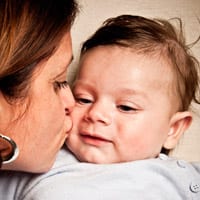Anxious about Autism?
All parents worry to some extent about their baby’s development—it’s part of being a parent. And the stark increase in the prevalence of autism can give even the most easy-going parents cause for worry. If you are anxious about autism, read on,
The Centers for Disease Control and Prevention estimates that 1 in 68 children in the United States has been identified as having an autism spectrum disorder. Autism spectrum disorders are almost five times more common among boys than girls, with 1 in 42 boys identified as being on the spectrum as compared to 1 in 189 girls.
The biggest increases in cases are among kids with an above-average or average IQ, says the CDC, and those kids now make up half of all autism cases diagnosed each year. The average age when the diagnosis is made remains at 4 or older, despite efforts in recent years to inform healthcare providers and parents alike that autism can be diagnosed in some kids as early as age 2.
Autism cannot be screened for prenatally, and the exact cause is still unknown.
Understanding autism
Autism is a complex group of developmental brain disorders known as Pervasive Developmental Disorders (PDD) and it presents differently for each child. Experts widely agree that early diagnosis leads to improved treatment and outcomes. Current research suggests that infants can show early signs of autism, even before their first birthday.
The American Academy of Pediatrics now recommends routine, formal screening by pediatricians at 18 and 24 months. Prior to this, your baby’s pediatrician will conduct a developmental assessment at each of your well-baby check-ups.
You may be asked about how your baby plays, interacts with you, sleeps, and makes his or her needs known to you. It’s important to discuss these fully with your baby’s provider; bring any concerns forward right away. Also, share with your pediatrician any family history of developmental disorders, being slow to develop communication, or poor social skills.
Seek evaluation early
Most states offer free developmental evaluations and therapy for children ages 3 and younger who meet certain criteria. These early childhood programs are generally free of charge and in most cases you won’t need a referral to attend—you can simply contact them to talk about your concerns. Start by learning where your child is developmentally, CDC experts say. Use their “Learn the Signs; Act Early” to help guide your conversations with your child’s healthcare provider.
Research shows that early intervention and treatment services are key to improving a child’s development when autism is present. These early efforts are targeted at helping your child learn to walk, talk and interact with others. Even if your child hasn’t been diagnosed with autism, if your pediatrician suspects your child is at risk for developmental delays, he or she may be eligible for early intervention under these programs, including an evaluation, under the Individuals with Disabilities Education Act (IDEA).
If you’re pregnant now, do everything you can to have the healthiest pregnancy possible. Relax and enjoy your pregnancy while taking good care of yourself. Get early and regular prenatal care, eat well and take prenatal vitamins, exercise, reduce your stress, and avoid dangerous behaviors like smoking, drinking, using unprescribed drugs, and exposure to chemical toxins. Engaging in healthy living during your pregnancy will always serve your baby well.
To keep up to date with the latest in developments regarding autism, visit the CDC’s autism site.
Potential Early Signs
Talk to your pediatrician if you notice that your baby is losing interest in eye contact, stops responding to his or her name, doesn’t make babbling sounds or facial expressions, or begins to play with toys in an unusual repetitive way as these are all traits seen in infants and toddlers who are later diagnosed with autism. AutismSpeaks.org also has more than 100 videos that will help you identify these behaviors in action.
| 2 months or thereafter | 6 months or thereafter | 9 months or thereafter | 12 months or thereafter |
| No turning towards sounds.No interest in watching people’s faces. | No big smiles or other warm, joyful expressions. | No back and forth sharing of sounds, smiles, or other facial expressions. | No babbling.No, or limited use of, back and forth gestures, such as pointing, waving, reaching, or showing you things.No turning to the person speaking when his or her name is called. |
RELATED TOPICS:
Newborn Hearing Screening May also Detect Autism
ALSO READ:
Debunking the Myths About Vaccinations
Does My baby have An Ear Infection






Comments are closed.